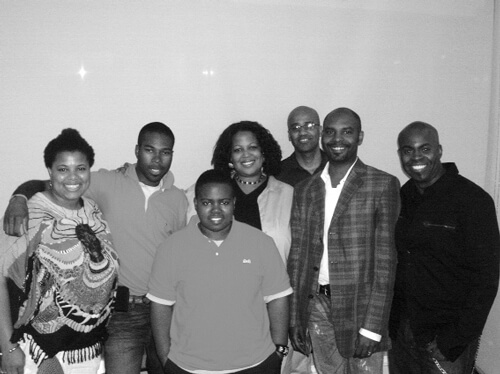NYU panel looks at challenge of accurately portraying African-American gays and lesbians
The panel last Friday at NYU discussing the invisibility of the African-American LGBT community in the media included: (l. to r.) GLAAD’s Katina Parker, the Task Force’s Jason Cooper, GLSEN’s Riley Snorton, Freedom to Marry’s Samiya Bashir, journalist Kai Wright, Ray Daniels of the National Black Justice Coalition, and filmmaker Maurice Jamal.
In a cultural, if not political sense, the United States has made dramatic advances in recent years in recognizing its lesbian, gay, bisexual and transgendered (LGBT)citizens. At the same time, there are many in the LGBT community who believe that the American public generally lacks a full grasp of the diversity within queer ranks. If that lack of awareness is to be effectively challenged, in whose hands does the responsibility lie?
On Friday, June 24, at New York University, Black Pride NYC teamed up with the Gay and Lesbian Alliance Against Defamation (GLAAD) to sponsor a panel discussion titled, “M.I.A.? Positive Black LGBT Images in Media.”
The panel, moderated by Katina Parker, a media expert at GLAAD, featured filmmaker Maurice Jamal (“Ski Trip”); Samiya Bashir, communications director for the Freedom to Marry Coalition; Jason Cooper, senior field organizer for the National Gay and Lesbian Task Force; Riley Snorton, a spokesman for the Gay, Lesbian, Straight Education Network (GLSEN); Ray Daniels, director of communications for the National Black Justice Coalition; and journalist Kai Wright.
“There’s no doubt that we’re there,” said Bashir. “But it’s always as the butt of a joke. We’ll be on a sitcom, but never in a drama. There’s never an attempt to show any sort of humanity. It’s always stereotypical.”
“Whether it’s film, or television or the front page of a newspaper, people need to understand that this is a money-driven process,” said Wright. “Artistry is nice, but at the end of the day, the people running these companies want to know if your story is going to bring money in the door. That’s the reality. It’s a business.”
Most of the panelists agreed that what imagery does exist in the major media plays itself out in extreme cases of stereotyping that began with the snap queen and have now morphed into a fascination with ‘the down low.’ Several speakers argued that the media continues to criminalize black gay men as either sexually exotic but inherently dangerous creatures or as promiscuous sexual deviants spreading disease and destroying communities. The panelists credited black lesbians for providing role models as mothers and caregivers within both the black and gay communities, but said their image, when it is present at all, is typically limited either to the role of an aggressive bull dyke or as fodder for heterosexual male fantasy.
“The only people who can change this is us,” said filmmaker Jamal. “Straight white people don’t sit around and talk about gay issues. Gay white people do. We have to take charge of our images ourselves. Too many people, other than ourselves, are painting our picture. We have to paint our own canvas.”
GLAAD’s Parker echoed the sentiment that the community must hold itself responsible, discussing her mother’s difficulty in accepting her daughter’s sexuality.
“To my mother, gay meant the white men she sees on television, and all the good and bad that goes along with those images,” Parker said. “She couldn’t comprehend how her daughter, her baby, fit in with that vision.”
Jason Cooper spoke of his experiences with the Task Force, going door-to-door in Atlanta doing voter outreach and encountering the attitudes that continue to prevail.
“People refused to believe that I was gay,” he said. “I didn’t fit the idea they had created in their head about what being black and gay means. One woman looked at me and said, ‘You don’t look like gay people. You look like my son.’”
The panelists gave a great deal of credit to LGBT youth of color, who are mobilizing in ways that generations before them never did.
“The young people are almost demanding control of their image and saying they refuse to be depicted in someone else’s eyes,” said GLSEN’s Snorton. “And many of these youth are black and Latino who are simultaneously challenging ideas of race.”
A difference in opinion amongst panelists and those the audience came when discussing the question of whether homophobia is more prevalent within the black community, with some seeing it as a smoke-and-mirrors tactic by the media to further divide the communities and others feeling that there is more truth to the statement than people are willing to acknowledge.
“People are more hostile when they can’t see you,” said Daniels of the National Black Justice Coalition. “But it stems more from ignorance than hatred. If they have nothing in their face challenging the thoughts that have been in their minds for years, it becomes extremely difficult to change their way of thinking.”
Parker brought the evening to a close stressing the need for the black LGBT community to mobilize itself to counter the inroads that the religious right has made recently in aligning itself with the black church-going community across the nation.
“We must begin to put our own image out there, whether it’s film, art, photography, snap queen or lesbian with a Ph. D.,” Parker said. “We can’t be heard, if we don’t allow ourselves to be seen.”
gaycitynews.com


































